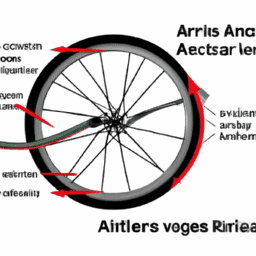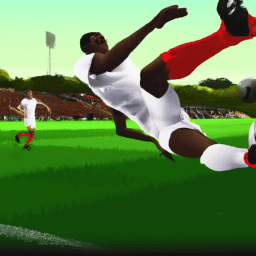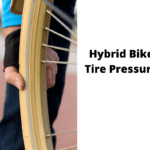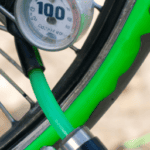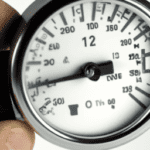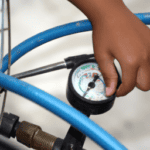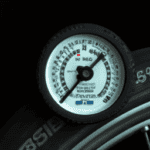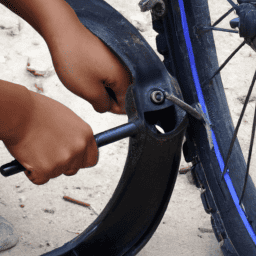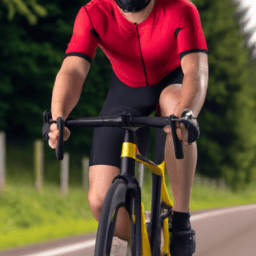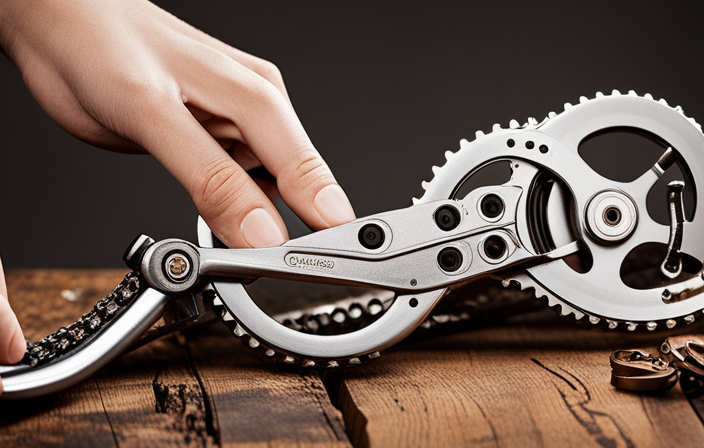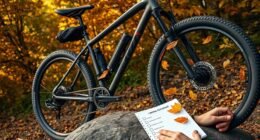As someone who rides bicycles, I am always mindful of the air pressure in my bike tires. This factor is essential for my performance while cycling, influencing everything from how fast I can go to how well I can maneuver on the road.
But have you ever stopped to wonder what causes this pressure and how it affects your ride?
The physics of gas and pressure play a major role in understanding the mechanics of a bicycle tire. It is important to understand the properties of the tire itself, as well as the factors that affect tire pressure.
In this article, I will delve into the science behind the pressure inside a bicycle tire and provide tips for maintaining proper tire pressure to optimize your cycling performance.
Key Takeaways
- Gas laws, such as Boyle’s law, affect the pressure inside a bicycle tire.
- Optimal tire pressure is impacted by factors such as tire size, material, construction, and rubber compound properties.
- Maintaining proper tire pressure is crucial for speed, efficiency, comfort, handling, and preventing flats and other issues.
- Regular maintenance and inspections, including checking pressure with a gauge and adjusting as needed, are essential for reliable performance and puncture resistance.
The Physics of Gas and Pressure
Gas inside a bicycle tire exerts pressure due to the physics of its molecules bouncing off the tire walls. This pressure is influenced by gas laws, such as Boyle’s law, which states that the pressure of a gas is inversely proportional to its volume at constant temperature.
Therefore, as the volume of gas inside the tire decreases (due to compression from the weight of the rider and bicycle), the pressure inside the tire increases.
The physics of gas and pressure inside a bicycle tire are important factors to consider when understanding the properties of bicycle tires. These properties, such as tire size and material, can impact the pressure needed for optimal performance.
The Properties of Bicycle Tires
The unique characteristics of bike tires determine their performance and ride quality. Bicycle tire construction involves several layers, including the tread, carcass, and sidewall.
The tread is the outermost layer, which comes in contact with the road and provides traction. It’s designed with patterns and grooves that vary depending on the type of terrain the tire will be used on.
The carcass is the layer that provides the tire’s strength, durability, and flexibility. It’s made up of layers of cords, typically made from nylon or polyester, that are woven together and coated with rubber.
Rubber compound properties also play a crucial role in determining a tire’s performance. The rubber used in bicycle tires is a specialized compound designed to provide optimal grip and durability.
The properties of the rubber, such as its hardness, stickiness, and flexibility, can be varied to suit different types of riding conditions. For example, a harder rubber compound is better suited for road riding, while a softer compound is ideal for off-road riding.
The impact of tire pressure on cycling performance is directly related to the properties of the tire construction and rubber compound.
The Impact of Tire Pressure on Cycling Performance
It’s quite amusing how a slight adjustment in the air level of your trusty two-wheeled companion can greatly affect your cycling prowess. Tire pressure is one of the most important factors that determine your cycling performance.
Here are some key points to consider when it comes to tire pressure and cycling:
- Optimal tire pressure can improve your speed and efficiency on the bike.
- Tire pressure affects the comfort and handling of your bike, as well as your ability to corner and brake effectively.
- Maintaining proper tire pressure is crucial for preventing flats and other tire-related issues.
Hydration and nutrition are equally important factors for achieving optimal cycling performance.
As cyclists, we often focus on the technical aspects of our sport, such as tire pressure and bike components. However, it’s important to remember that our bodies also play a critical role in our performance. Proper hydration and nutrition are essential for maintaining energy and endurance on the bike.
In the next section, we’ll explore the various factors that can affect tire pressure and how to maintain optimal levels.
Factors that Affect Tire Pressure
As a cyclist, I know that tire pressure is crucial to my performance on the road.
There are several factors that can affect tire pressure, including temperature and altitude, air leakage and maintenance, and tire wear and damage.
Understanding these factors and how they impact tire pressure can help me maintain optimal performance and safety while cycling.
Temperature and Altitude
Feeling anxious about your upcoming mountain biking trip? Don’t forget that changes in altitude and temperature can affect the pressure in your tires, so be sure to check them before hitting the trails.
Temperature variations are one of the biggest factors that affect tire pressure. As the temperature increases, the air molecules inside the tire expand, causing the pressure to increase. Conversely, as the temperature decreases, the air molecules contract, causing the pressure to decrease.
Altitude changes also affect tire pressure. As you go up in altitude, the air pressure outside the tire decreases, causing the air inside the tire to expand. This can lead to an increase in tire pressure, which can be dangerous if it exceeds the maximum pressure recommended by the manufacturer.
Therefore, it’s important to check your tire pressure before every ride, especially if you’re going to be riding in different altitudes and temperatures. With proper maintenance, you can prevent air leakage and ensure that your tires are always in optimal condition.
Air Leakage and Maintenance
To keep your bicycle tires in top condition, it’s important to prevent leakage and maintain them regularly. Air leakage can occur due to punctures, cut sidewalls, or worn valve stems. To prevent leakage, you can use sealants or puncture-resistant tires. However, it’s important to inspect your tires regularly to ensure they are still in good condition.
If you do notice a significant amount of air loss, it may be time for a tire replacement. Over time, tires can wear down and become damaged due to exposure to the elements and rough terrain. When replacing your tires, make sure to choose ones that are compatible with your bike and riding style.
Proper maintenance and tire replacements can help ensure your ride is safe and smooth. Speaking of safety, let’s now dive into the topic of tire wear and damage.
Tire Wear and Damage
Proper maintenance and regular inspections are key to preventing premature wear and tear on your bike’s tires. One of the main causes of tire wear is overuse, particularly on rough or abrasive surfaces. Another factor that can contribute to premature wear is under-inflation, as this can cause the tire to flex excessively and create excessive heat, which can weaken the rubber.
To prevent such issues, it’s important to check tire pressure regularly and adjust it as needed to ensure optimal performance and puncture resistance.
In addition to maintaining proper tire pressure, it’s also important to inspect your tires regularly for signs of damage. This can include cuts, punctures, or other signs of wear and tear that can compromise the integrity of the tire. By identifying such issues early on, you can take steps to repair or replace the tire before it becomes a safety hazard.
With proper care and attention, your bike’s tires can provide reliable performance and puncture resistance for many miles of enjoyable riding. Next, I’ll discuss some tips for maintaining proper tire pressure.
Tips for Maintaining Proper Tire Pressure
Maintaining the right tire pressure can make all the difference in how smoothly your bike ride goes. It not only ensures a comfortable ride, but also helps to prevent flats and extend the life of your tires. To maintain proper tire pressure, it is important to be consistent and use the right tools for checking.
One important tool for checking tire pressure is a tire gauge. A gauge will accurately measure the pressure in your tires and help you determine if they need to be inflated or deflated. It is also important to check your tire pressure regularly, preferably before every ride. Consistent monitoring of your tire pressure will help you catch any issues early on and prevent any serious damage to your bike. To make things easier, you can also keep a record of your tire pressure readings in a chart or table, so that you can easily track any changes over time.
| Tire Pressure | Front Tire | Rear Tire |
|---|---|---|
| Minimum Pressure | 40 psi | 45 psi |
| Maximum Pressure | 65 psi | 70 psi |
| Recommended Pressure | 55 psi | 60 psi |
In addition to using a tire gauge and checking your tire pressure regularly, it is also important to adjust your tire pressure based on the terrain and weather conditions. For example, if you are riding on rough terrain or in wet weather, you may want to slightly reduce your tire pressure to improve traction. On the other hand, if you are riding on smooth pavement, you may want to slightly increase your tire pressure for a smoother ride. By following these tips and maintaining proper tire pressure, you can ensure a safe and enjoyable bike ride every time.
Frequently Asked Questions
How often should I check the tire pressure in my bicycle tires?
I check my bicycle tire pressure once a week to ensure optimal performance and safety. Valve types are important in maintaining accurate pressure readings, while factors such as temperature and altitude can affect measurement accuracy.
Can using a pump with a higher PSI rating than my tire requires cause damage?
Using a pump with a higher psi rating than my tire can cause overinflation, leading to potential damage and increased risk of a blowout. Matching the pump gauge to the tire requirements is important to avoid these effects.
How does temperature affect tire pressure in bicycle tires?
Temperature affects tire pressure in bicycle tires. Effects of altitude also change pressure. To properly measure pressure in different weather conditions, use a gauge. Be precise to avoid damage caused by overinflation.
What is the recommended tire pressure range for different types of bicycles (road, mountain, etc.)?
For optimal performance, it is important to maintain the recommended tire pressure range for your specific bike type. This range takes into account the bicycle tire construction and ensures proper handling, traction, and stability.
Can low tire pressure cause punctures or flats in bicycle tires?
Low tire pressure can increase the risk of flats and punctures, especially on rough terrain. Using tire sealant can help prevent punctures by filling small holes. It’s important to regularly check and maintain proper tire pressure.
Conclusion
In conclusion, understanding the physics of gas and pressure, as well as the properties of bicycle tires, is crucial to maintaining proper tire pressure and achieving optimal cycling performance.
While factors such as temperature and altitude can affect tire pressure, regular maintenance and checking tire pressure before each ride can prevent over or under inflation.
Now, some may argue that constantly checking tire pressure is tedious and time-consuming. However, the benefits of proper tire pressure, including improved handling, reduced rolling resistance, and decreased risk of flats, far outweigh the minor inconvenience of checking tire pressure.
As a cyclist, it’s our responsibility to ensure the safety and longevity of our equipment, and maintaining proper tire pressure is a crucial aspect of that.
So, next time you hit the road, take a few extra minutes to check your tire pressure and enjoy a smoother, more efficient ride.
